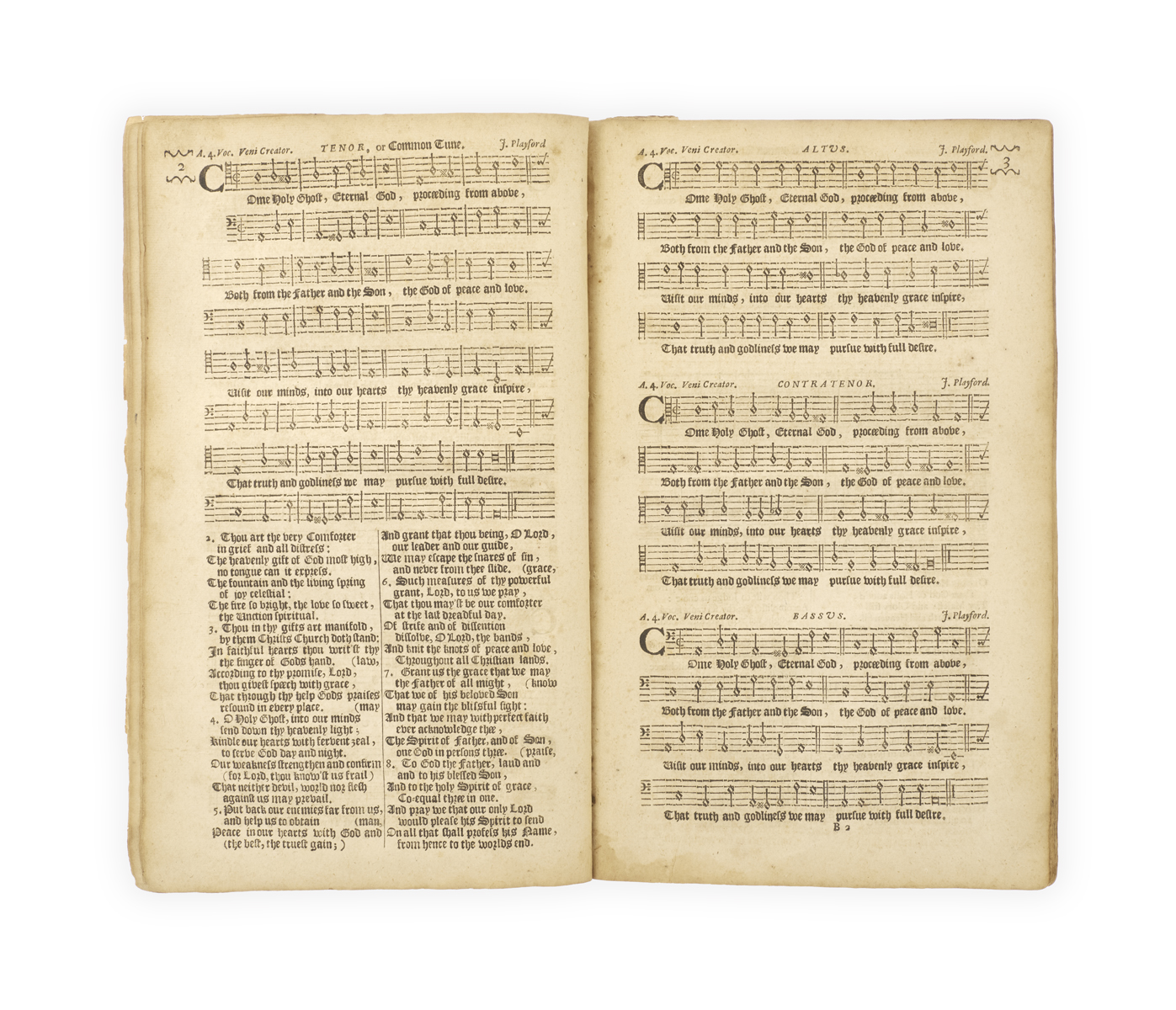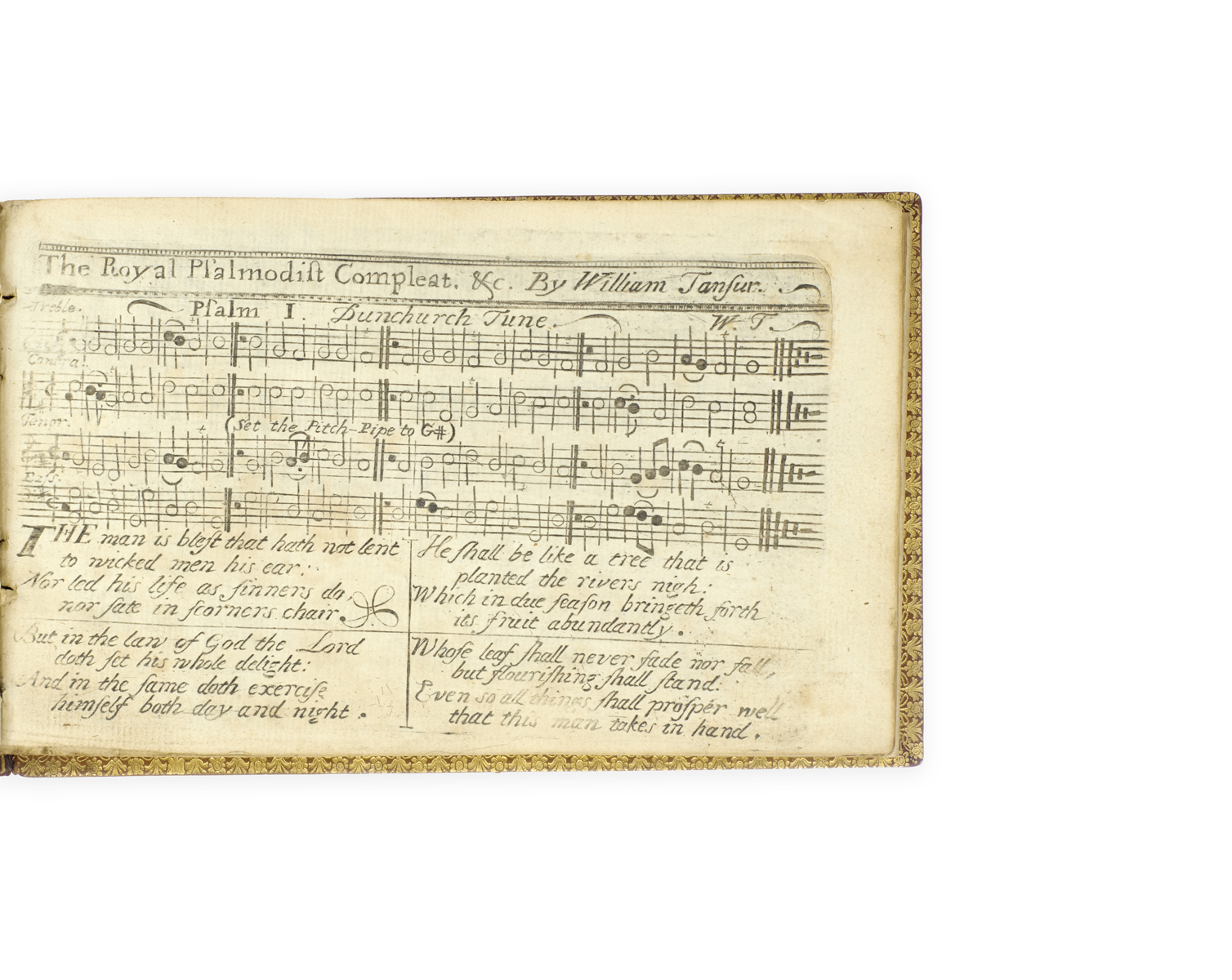

FOUR-PART HYMN TUNES
PLAYFORD, John.
Psalms & Hymns in solemn Musick of foure Parts on the common Tunes to the Psalms in Metre: used in Parish-Churches. Also six Hymns for one Voyce to the Organ …
London, Printed by W. Godbid for J. Playford, at his Shop … 1671.
Folio, pp. [12], 12, 17–97, [3], complete despite pagination, with an engraved vignette on the title-page surrounded with letterpress music, and a leaf facing the titlepage with ‘A Hymn on the divine use of musick’ by John Jenkins (portion torn away at foot with loss of Jenkins’s name); tear to V1 without loss, slightly toned, a few spots, withal a good copy in recent wrappers.

Added to your basket:
Psalms & Hymns in solemn Musick of foure Parts on the common Tunes to the Psalms in Metre: used in Parish-Churches. Also six Hymns for one Voyce to the Organ …
First edition of the first harmonised Psalter after the Restoration, a landmark work in the re-introduction of part-singing into churches.
Most earlier English harmonised psalters, such as that of Ravenscroft (1621), had been intended for domestic not parish use, but Playford’s intent was ‘to restore this part of Gods Service to its former Honour and Esteem’, and as such he gave a number of copies of his Psalms & Hymns to the Company of Parish Clerks of London. ‘I have done but one half in Setting the Musick, which yet remains as a dead letter: It being your part to Complete it, and to add life to its Harmonious body, by your sweet According Voyces’. It was ambitious given that even in London many churches still lacked an organ or a choir. ‘Success came only after his death, with the burgeoning of voluntary parish choirs in the 1690s; many of his tune harmonizations were used throughout the 18th century in England, Scotland and North America’ (Oxford DNB).
Playford’s long ‘Preface’ analyses the current state of psalmody, finding both the tunes and the poetry wanting. Sternold and Hopkins were ‘Men whose Piety exceeded their Poetry’ (Playford should know, as the printer of twenty-three editions after the Restoration), and their metrical psalms will no longer serve, nor will many old tunes, inappropriate to the psalms they set. Playford’s concern was to record the current popular version of hymn tunes, to restore some old tunes to present use, and to match tune to psalm appropriately not ad hoc. He includes six new hymn tunes of his own composition (though closely related to existing tunes), and variant translations are provided for some psalms, as well as suggestions of other psalms that can use the same tune.
‘In harmonizing the tunes, Playford essentially added two counter-tenor parts, one high, the other very low … The resulting four-part texture is rich and dark, especially when a soprano line is added in octaves with the tenor, as Playford suggests in the preface’ (Nicholas Temperley, ‘John Playford and the Metrical Psalms’, Journal of the American Musicological Society 25:3, 1972). At the end are six tunes for one voice and an accompaniment, including a setting of George Herbert’s ‘The Altar’; a four-part Gloria Patri by Benjamin Rogers; and a canon on Psalm 115.
John Playford (1623–1686?), was the pre-eminent music publisher of his day, exercising a virtual monopoly in this field under the Commonwealth and earlier years of Charles II through his close connection to the Stationers’ Company; he was known and admired by Purcell who set a pastoral elegy by Nahum Tate after his death. As a publisher he had pioneered the use of type-set rather than engraved music.
Wing P2498.

